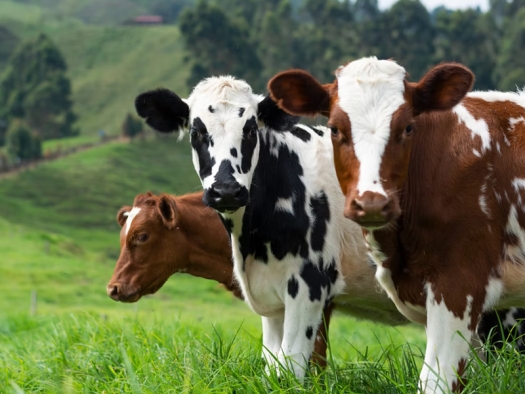The late 1980s and 1990s were full of scary predictions about mad cow disease. It was caused by prions which were transmissible from one animal to another and also to humans via the consumption of the meat. The prions survived temperatures much higher than normal cooking. If you were a meat-eater, you were doomed. The world was set to be inherited by strict vegetarians within the next decade. It was just a matter of time.
Governments all over the world would destroy entire herds of cattle if one or two cows were proven to be “mad.” Ranchers were left with no recourse and were frequently financially destroyed.
The entire world waited for “the other shoe to drop.” But it never did. Neither mad cow disease, nor the human form of the disease, Creutzfeld-Jakob disease, ever advanced much beyond the few international “hot-spots.” Decades later the world seems unconcerned about it all. Occasionally, you will see an isolated article about Bovine Spongiform Encephalopathy (AKA mad cow disease), scrapie (the sheep version of this disease), or brain-wasting disease in deer or elk, but these seem to draw as much attention as little-league baseball scores.
The strange footnote to all these developments is that the writers of these articles, the health authorities, and the public all appear to still subscribe to the same fundamental ideas about mad cow disease that led to a slow-motion hysteria just 30 years before. So, even though the disaster that would logically follow from the accepted understanding fell apart like a house of cards, the belief in those ideas still remains with us today. Somewhere along the line, almost everyone forgot to question and re-analyze something that was obviously very wrong.
Mark Purdey
I did say “almost everyone” because there were a few people who did arrive at very convincing explanations for mad cow disease (along with scrapie, Creutzfeld-Jakob, and brain-wasting disease). The most prominent one was Mark Purdey. He had no advanced degrees. He was not a doctor, research scientist, chemist or biologist. He was a British organic cattle rancher. In Britain, there was an outbreak of problems with warble fly, and the British government had decided to require Phosmet to be used on all cattle. Phosmet is an organophosphate pesticide that would be applied to the cattle’s back roughly tracing the spine.
Warble flies are a legitimate problem that require some kind of a response.1 The eggs are laid on large animals. When the eggs hatch, the larvae penetrate the skin and migrate through the animal throughout their life cycle. When there are enough holes in the hide, the leather of the hide is unusable. As it migrates through the animal’s body, there is also the potential to damage to the meat and it causes ongoing health problems. The mitigating factor is that most infections are minor.
Mr. Purdey objected to the idea of having to put this pesticide on his entire herd when no animal in his entire herd had every been infected by warble flies. He took his complaint to court and won.2
He made this legal challenge because he already knew that Phosmet was known to disturb the balance of metals in the brain and central nervous system. The location that the British government required application of Phosmet was along the spine, which would be millimeters away from the prion-protein-expressing cells of the spinal cord. One specific characteristic of organophosphates is that they are acidic. This makes them capable of affecting metal concentrations.3 In fact, it is well known that organophosphate pesticides are aggressive chelators.9
Later Purdey noticed that cattle were popping up with a new neurological disease called “mad cow” disease. He also noticed that almost always happened to cattle that had been treated with Phosmet.
It is worth noting that mad cow disease seemed to have originated and was strongest in Great Britain, which is where the national government required doses of Phosmet four times higher than in any other country.2
The short version of this story is that Mr. Purdey proceeded to look into the causes of mad cow disease. This took years and took him around the world. He traveled to look at hot spots and this helped him to establish his theory of the cause of mad cow disease along with scrapie, Creutzfeld-Jakob, and brain wasting disease in deer and elk.
Here is a summary of his findings:
A prion is a naturally-occurring protein that is almost never pathological.4 In its’ normal state, it has 6 copper atoms. We all have prions, and I can say with statistical near-certainty that your prions are not causing disease.
If an animal is very copper deficient, then creating prion proteins becomes difficult. If a another metal ion is available, it might be substituted if no copper is available. The most common problematic substitute metal ion is manganese. Manganese is not as electrically-conductive as copper so it does not interact with electrons as strongly as copper.
Here is a quote from Mark Purdey’s article:
“... copper is used in wires that carry electronic currents, whereas manganese is used in batteries and light filaments that store electrical energy. This helps explain< the underlying cause of prion diseases ...”2
It is also useful to note that the common use of manganese in batteries is as a cathode. The cathode is the terminal of a battery that maintains a positive charge.7 The common possible charged states for a manganese ion are 2+, 4+, and 7+.8
Here are two of my additions that I thought would be useful at this point:
- The definition of a free-radical is an atom or a molecule that is missing one or more electrons. Of course, when you lose an electron, which is negatively charged, this makes the resulting molecule more positively charged. That makes it unstable and very prone to damage adjacent molecules by stealing an electron from them.5
- A prion made with one or more manganese ions is much more prone to lose electrons than a prion made with 6 copper ions. This means that it is prone to become a free-radical. Those made with several manganese ions can become very destructive free radicals. Also, those made with multiple manganese ions that have become 4+ and possibly 7+ would be extremely destructive free radicals.
Simply being copper-deficient in the presence of a manganese excess does not by itself create these diseases. First the free radicals must be created. The electrons only leave their atom if they are energized enough to overcome the pull of the charge of the atom’s nucleus (which is always positive and holds onto the electrons, which are negatively charged). In order to create the mad cow collection of diseases, a significant energy input needs to be added. The energy input might occur in any average environment, but it should be noted that mad cow disease “hot spots” are probably going to be in places where the energy input is strong and frequently occurring. Some examples would be:
- Explosions
- Strong UV light especially sunlight coming into the eyes
- Very loud sounds
Soil tests conducted all over the globe have fairly consistently found very low copper levels and very high manganese levels wherever the animal versions of mad cow disease are occurring frequently. This has also been found at autopsy in the brain tissue of mad cow and CJD victims2.
The use of rendered meat and bone meal (MBM) as animal feed is a very poor predictor of where mad cow, scrapie, or brain-wasting diseases will break out.2
Several US trials tried to induce mad cow disease in cattle after feeding or injecting them with massive doses of Spongiform Encephalopathy-containing brain tissue. All of these trials failed to induce any mad cow disease.2
Culling entire herds of sheep, cattle, deer and elk have not been successful at eradicating an outbreak of these diseases. When healthy animals are reintroduced to the same area, the diseases return.2
Icelandic and Sardinian sheep farmers have traditionally feasted off their sheep as soon as they show the early stages of scrapie (this involves the consumption of the brains and all) because they know from experience that the poor beast will rapidly waste away to skin and bone. Yet these farmers have not demonstrated any incidence of CJD as a result. This kind of epidemiological data is strangely ignored.6
How this narrative went wrong
It is easy to imagine how not everything is understood clearly at the beginning of a scientific investigation. However, why things continue to be institutionally misunderstood after clear explanations have been put forth requires a little bit more of either cynicism or sense of humor. Here is Mark Purdey’s version of an explanation:
“It is easy to see how such a reductionist mindset took hold: the media loved the theory because they could drum up a viral holocaust-horror scoop. The vegetarian lobby found themselves with a powerful propaganda weapon on their plate. Scientific institutions could carry on drawing generous funding for their hyperinfectious witch-hunt without the embarrassment of having to account for years of barking up the wrong tree. And the government could conveniently off-load the blame onto the vagaries of some naturally-occurring phenomena for which no vested interest (such as the pesticide producer) or official directive could ever be held accountable.”2
I added the “pesticide producer” aside to his quote.
Concluding statements
Mad cow disease is exactly the same disease as scrapie in sheep, CJD in humans, and brain wasting disease in deer and elk. This disease is not contagious in any typical way. Eating meat is not a cause of this disease. However, I should point out that a steady diet of copper-deficient food that contains excessive amounts of manganese will eventually replicate the reasons why these animals developed this disease. This could come from a vegetarian diet just as easily as it could come from a diet that contains meat from sheep with scrapie and beef from “mad” cows as long as it was never counter-balanced by an adequate source of copper.
Prions are a naturally-occurring protein in all of these animals including humans, and when prions are made with copper, they are not pathological.
This disease exists because if prion proteins are created without enough copper to complete a normal prion and manganese is substituted in the place of copper, then dangerous electrical things begin to happen. The manganese is much more prone to become highly positively charged, which means the prion becomes a strong free-radical. Because there can be multiple manganese substitutions in a single prion, the prion can become a very powerful free-radical. These diseases are what it looks like when a brain is exposed to free-radical damage on a large scale.
We should not shudder in fear of CJD or mad cow disease just because the official narrative is covering for so many misdeeds that it is incapable of informing us how to protect ourselves. It all starts with a severe copper deficiency. Don’t go overboard on copper, because copper excess creates problems too, but just making sure that your blood copper levels don’t get significantly deficient should be enough to keep you protected.
References
- Warble Fly, Wikipedia
- Mark Purdey, Mad Cow Disease
- Organophosphate, Wikipedia
- NIH, Prion Protein: The Molecule of Many Forms and Faces
- Lynn Eldridge MD, Free Radicals: Definition, Cause, and Role in Cancer
- Mark Purdey, Mad Cow Disease and the Mad and Useless Global Slaughter of Animals
- Yixuan Guo and Yixiang Zhang, Manganese-based materials as cathode for rechargeable aqueous zinc-ion batteries
- ThoughtCo, Element Charges Chart
- Sukhmanpreet Kaur dt al, Pesticides Curbing Soil Fertility: Effect of Complexation of Free Metal Ions



